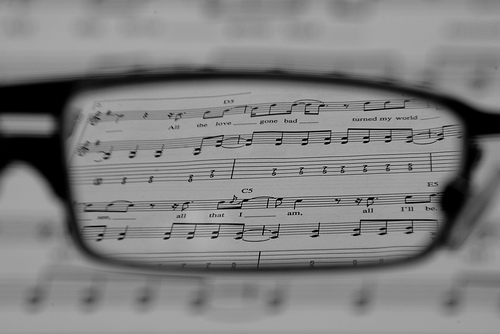Who wants to do some sight reading!? Who wants to do some sight reading in front of your teacher!? How about in front of a jury committee? Or, how about sight reading at an audition for your “dream job”?
I am guessing that these ideas were not registering very high on your “favorite things to do” list. However, if you are a serious musician or someone considering being a serious musician, these are all things you are going to have to contend with. Sight reading is a skill that all of us who aspire to play music at a high level need to work on, constantly. I try to set practice time aside specifically for working on sight reading. I use etude books, jazz transcription books, duets, pretty much whatever. My goal during this particular part of my practice session is just to get through pages, I don’t “practice” hard parts or things I missed, I just read the music like I might read a magazine.
There are a bunch of great methods out there for developing sight reading and I would just like to offer two approaches – make it easier and make it harder.
The idea of making an already difficult task more difficult hopes that once we stop adding that additional level of difficulty the remaining task will feel easier by comparison. It’s the concept of running with weights on. It’s so much easier once you take the weights off! I think the reality of this is that your brain physically has less to process once the “weights” are off, and can work more efficiently and faster. Simply, take an etude book that you use for sight reading purposes and transpose. Transpose to different keys or intervals that you are accustomed, and change the transposition interval after each etude or page, to make it more challenging. Changing your transposition keeps that “added weight” nice and fresh!
Use the “make it easier” approach when sight reading actually matters, like at an audition or jury. The “make it easier” approach is all about Prioritization. One of the things that make sight reading so “un-fun” is that we often don’t sound very good, or at least are more prone to making mistakes in the process of sight reading. Once we miss something while playing it triggers a “displeasure factor” in our brain which starts the whole nerve-fight-or-flight-thing and usually results in a snowballing effect of degradation (and humiliation!). The fact is there is a tremendous amount of information that needs to be processed, addressed and executed every time we play music. Depending on the level of difficulty of the music it may be simply unreasonable for us to expect, or think that we can execute that particular passage of music perfectly the first pass through it. This sounds weird but if we lower our standards and just focus on the first couple priorities and train ourselves to be alright with letting the lower (or actually higher level) priorities go, then we will feel more success and our brain will approach this task with more confidence. Our brain will have less to process and work more efficiently in the result. I also like to think of this process like putting blinders on, or perhaps looking at the music through a telescope. The first pass my telescope is only seeing rhythms. Once that is easy I then widen my scope to take in more musical elements like perhaps accidentals, then dynamics, then articulations. The following picture kind of represents what I am trying to describe.

I feel strongly that when sight reading, especially with other musicians or in an ensemble; the first priority that we all should be focusing on is rhythm and rhythmic identification. If we are all playing along and I miss an F-sharp, or slur three notes when I’m supposed to slur two, I may get a nasty look from the conductor, but it is not going to be that detrimental to the overall ensemble. However, if I were to play triplets when everyone else is playing duples, or come in a beat early to everyone, there is a chance my rhythmic inaccuracy could bring the whole band to a crashing halt! That’s why rhythmic integrity is of the utmost importance.
The following table is just a sample priority list that one may use for sightreading purposes. It by no means represents everything one needs to account for when playing music and the overall order is completely subjective and dependent on each and every musical passage. It is just a generalization and place to start.
If a piece I am about to sight read is really difficult, I start by scanning the page and seeing if there are rhythms that are confusing. I think those through in my head then go back to the top and go down my list, “what’s the key”, “what’s the overall style”, “are there accidentals outside the key signature that make things look confusing”… Like I said earlier, if the piece is really hard I may be able to only focus on the first couple of priorities. If it’s a real easy piece, hopefully I can widen my scope where I can see all ten priorities.
| Sight Reading Priorities | |
| 1 | Overall Rhythm (Time/Pulse) |
| 2 | Rhythmic Accuracy |
| 3 | Key Signature |
| 4 | Style (Leggiero vs Pesante,
Marcato vs Legato…) |
| 5 | Accidentals (right notes) |
| 6 | Tone |
| 7 | Articulations |
| 8 | Nuance/Lyricism |
| 9 | Rubato |
| 10 | Vibrato |
This list comes from a post I recently wrote called Just Another Song and Dance. That post is somewhat related to this sight reading post in that it also talks about priorities in music making.
